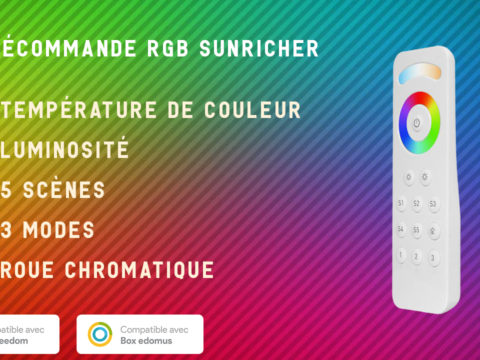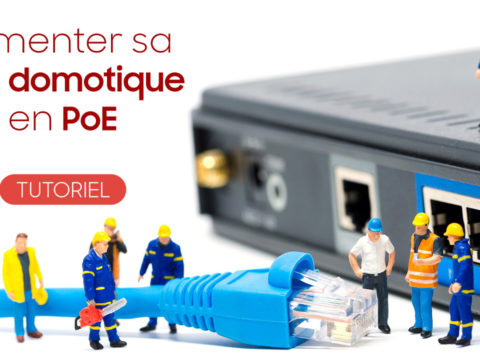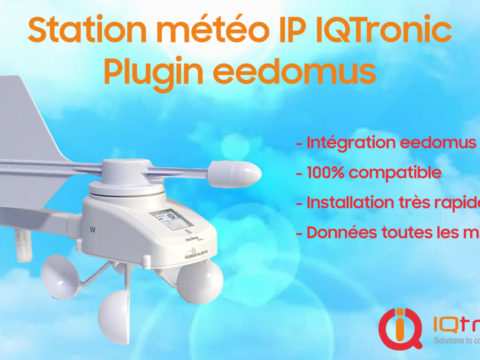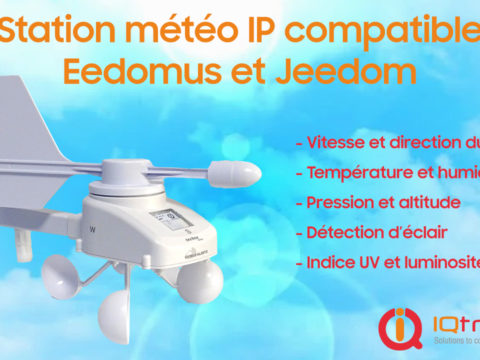This guide explains how you can easily add products using the Orno Smart Living communication protocol on the home automation system eedomus, using the USB dongle RFPlayer. We aim to cover many different home automation systems that are compliant with the RFPlayer.
We already discussed the RFPlayer on this blog. It’s a communication gateway, connected through USB, for various home automation protocols. It transmit and receive signals in various protocols, thanks two its two antennas which allows it to communicate on the 433 MHz and 868 MHz frequencies. It also has some other built-in features, and we advise you to read our post of introduction to the RFPlayer to discover them.

RFPlayer on eedomus adds many protocols to the system
Eedomus has Z-Wave built-in, but one of the big strengths of this system is its two USB ports, which allows to connect various devices (such as an USB-to-3G/4G dongle to keep an Internet connection in case of default), or extension to communicate in wireless protocols. For example, the eedomus can make use of an EnOcean gateway, or a gateway bringing many protocols, like RFXCom since some years, or in this case, the RFPlayer, which is totally compliant with the eedomus since its update of February 2017.
The icing on the cake is that using a RFPlayer on an eedomus is quite easy: we just have to plug the RFplayer on one of the USB ports at the back of the eedomus (while taking care of spreading the antennas to avoid them to interfere with each other), directly, or through an extension cord or a USB hub. The RFPlayer is directly ready to use and the user can configure it and see the radio frames received by the RFPlayer.
The RFPlayer has its own settings section. You will find it in « Configuration« , « Your devices« , « eedomus controller » section (to unfold) an the link « Configure » :

In the eedomus settings, you will find a « Ziblue RFPlayer » section that allows you to set how every protocol is taken care of: Receive, Repeat, or Receive+Repeat. By default, every type is set on Receive. You can also totally disable some protocols if you don’t need them.

The selection box « Show notifications » allows notifications to be shown every time a new device is detected. It can be totally disabled (which can come in handy in some cases), but usually, and especially when we want to add devices, it’s recommended to keep it on. It allows for an easier creation of devices.
If, like us, you have many Oregon Scientific sensors in your setup, they will quickly all be shown in the notification bar as soon as the RFplayer is plugged in! We just have to click on the creation link to add them, this way we can have their values displayed on the eedomus UI and use them in scenes.

Here, for instance, we have two Oregon Scientific sensors (and one of them is displayed twice). For every sensor, every type of measure has its own line. Here, it’s easy to distinguish our two devices since one of them is a thermometer / hygrometer, and the other one also measure pressure. But in the event there are more sensors, it’s recommended to add them one by one, for example by putting batteries on the devices step by step to make sure we correctly recognize every device we add.
Adding a new Oregon Scientific sensor with the RFPlayer in eedomus is so easy that we thought a full dedicated post wasn’t necessary, but if you think it could be useful, don’t hesitate to ask us in the comments!
Orno Smart Living products, totally compliant with the RFPlayer
The products we’ll add through the RFPlayer are Orno Smart Living products. They use the 433 MHz AC protocol, also known as the CHACON protocol. It’s a protocol that works with an association system and we regularly talk about it, since it’s easy to use and isn’t expensive.
The Orno Smart Living products are the following:
| Transmitters | Receivers / actuators |
|---|---|
|
There is also the Wi-Fi power socket controller from Orno, which is more than just a remote-controlled power plug since it can be used as a gateway between Orno’s mobile app (connected to the power socket through Wi-Fi) and various Orno Smart Living devices. But this socket is particularly suitable for small setups. Here, our control system is the eedomus and our gateway is the RFPlayer!
For the following test, we will use a remote-controlled dimmer power socket Smart Living, a 2-channels remote control and a one-button wireless switch.

Amongst compliant devices with the 433 MHz AC protocol, for which all that follows also applies, you will also find:
- Chacon/DI-O controlled by the association system. Note that the older Chacon devices work with the DOMIA protocol (with a coding wheel), which is also RFPlayer-compliant;
- Intertechno and Smartwares products
- Other products brands such as CoCo, Trust, HomeEasy.
Make sure that the devices you purchase do work with this association system and that the manufacturer doesn’t make several ranges of products with different protocols. It is the case for Orno: there are other Orno products outside the Smart Living range, that work with another association system, which isn’t 433 MHz AC.
Adding the Smart Living remote and wall switch with the RFPlayer
As we saw before, adding a transmitter is quite easy. It’s the case for a Oregon Scientific transmitter, but also for a 433 MHz AC type.
We take the remote control and simply press the « ON-1 » button, which correspond to the ON of its first channel. A notification for a new radio frame appears on the top on the eedomus UI:

The device is recognized, with the protocol it uses (here shown as CHACON) and a radio ID. We can just click on « Create it automatically ». Before we access the creation screen, the following prompt appears:

As it’s written in the prompt, we can pick which kind of device we add: a regular sensor, or an actuating sensor. That’s because among protocols known by the RFPlayer, some of them need to be associated to the system by sending a radio frame, but can be afterwards controlled by the system.
For example, a shutter module communicating in the Somfy RTS protocol will be added to the system by using its remote control (which is a transmitter), but it is necessary to create the device as an actuating sensor, to enable the eedomus system to control the shutter. In the same way, the KD101 smoke detector is a transmitter (since it sends a radio message when smoke is detected), but it’s also an actuating sensor that can be triggered remotely (KD101 detectors can be connected together and are meant to trigger each other. With this kind of integration, the home automation system itself can trigger the smoke sensor alarm remotely).
In our current case, where we’re adding a remote controller and a wall switch, we add a simple sensor, so we click on « No« . The devices we’re adding are design to send themselves radio frames to emitters, without receiving such messages or being triggered themselves. The same goes for motion sensors, door and window sensors, etc.
After picking the option of a sensor, we are directly on the configuration screen for this device, where we can name it, pick its use, and optionally indicate the Room (which is meaningful for wall switch but won’t usually be interesting for a remote control).
Because we clicked on « Create it automatically », the created device automatically gets the radio identifier that was in the eedomus notification, and it’s put on the right field.

Therefore, product creation is really simple, and after saving the product configuration, it shows up in the eedomus UI, and we directly see the buttons pushed on the remote : ON for ON-1 and OFF for OFF-1.

Every channel from a remote needs to have its on device on the eedomus UI. That’s why ON-1 and OFF-1 are directly integrated to this device and won’t appear again in the notification zone, while ON-2 and OFF-2 appears as devices that need to be created. We just have to add the 2nd channel, exactly the same way.
The same goes for a three-channels remote, or for a double switch: every channel has its own identifier code and need its own device on the UI. For a single switch, there is only one channel where its ON and OFF commands are transmitted, so only one device is needed.
The manual creation of a RFPlayer device is possible but not advised, since it doesn’t add any advantage. To do so, we go to « Configure« , Add or remove a device« , « Add a different type of device« , and we scroll to « Radio extensions », where there are two icons for The RFplayer, allowing the creation of an Actuator and a Sensor.

Only, if you create a sensor this way, you will still need to get the radio identifier in the notification bar, to copy it afterwards on the « Identifier » field of the device. And on top of that, you will have to set up the rest of the sensor. Thus, the easier and faster way to proceed is clicking on « Create it automatically », there is no peculiar reason to create the sensor another way.
Add an Orno Smart Living actuator device with the RFPlayer
Now that our transmitters are added, we can know add a receiver actuator! This time, we will need to use the manual creation of the device. We will add the Orno Smart Living dimmer wallplug.

Similarly to what we saw before regarding the manual creation of a Sensor, we will manually add our actuator. To proceed, let’s go to « Configure« , Add or remove a device« , « Add a different type of device« , we scroll to « Radio extensions« , where there are two icons for The RFplayer. We click on the « RFPlayer – Actuator » icon.

This brings up the new device creation screen. Other than the usual Custom name, Use and Room for the device, we have two settings to set: the Protocol (as seen before, 433 MHz AC is called CHACON on the RFPlayer) and the Identifier, in digits or pseudo-X10 code. The identifier is set arbitrarily, since it’s a code that will be transmitted by the RFPlayer to control the device. So all we need to make sure is to pick a code that doesn’t exist, and to do the necessary handling to associate this code to our receiver device.
When creating a new device, the eedomus automatically picks an unused radio identifier, so you can keep it as it is. You can also replace it with a code of your choice, but in this case make sure that this code isn’t already used by another transmitter or receiver device.

In the way the RFPlayer is managed on the eedomus, some protocols like CHACON allows both the digits codes or the pseudo-X10 identifiers, while other protocols such as X10 or Domia only works with codes using this template.

After we saved our newly created eedomus device, we still have to associate this device to the actual device. To do so, we need to have the device control on the eedomus UI within reach.
We need to set the physical device in association mode. On a big majority of modules working in AC 433 MHz, the association mode is started by holding down the learn button during 3 seconds, and a LED starts blinking, indicating the device waits for a transmitter’s code. This is the case for the Orno Smart Living dimmer wallplug: we just have to hold 3 seconds the On/Off Learning Code button in the front of the plug, and the green light starts to blink.

We need to send the radio code that we want to associate on it. To do so, we click on the « Actuator » device that we just created on the eedomus UI, and we choose the ASSOC command. By doing so, the RFPlayer will send an association code with the radio Identifier we chose before.

The wallplug’s LED blinks twice (and if a load is plugged in, it blinks twice too) to confirm the correct association. Now, we can directly control it remotely from the eedomus UI by clicking « On » and « Off », and even diming values.
In this case where we have a dimmer module associated, we can make the UI look even better. First, we click on the top right corner of the device to access « Device configuration ». Then, we go on the « Values » tab. On this screen, we can uncheck the display of « ASSOC » and « DISSOC » values since they’re useful only to associate and dissociate the plug from the code sent by the RFPlayer, and instead of those, we can pick as displayed values intermediary dimming percentages. If we only need to switch something ON and OFF, we can just left checked those two values and uncheck all the rest.

For example, here is below how our Orno Smart Living Plug appears on the eedomus UI after we only checked the ON and OFF values and three diming values:

Summary
As we saw above, the way the eedomus handles the RFPlayer is pretty good. It makes a widespread automation protocol, such as the 433 MHz AC, really easy to use. The method to use the various devices is not exotic for those familiar with this protocol, but which stays easy to understand and to use for newcomers. In a nutshell, it’s a really well-done implementation. And keep in mind that’s only a small part of what the RFPlayer is able to do!






